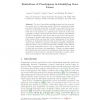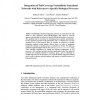6 search results - page 1 / 2 » Limitations of Pseudogenes in Identifying Gene Losses |
RECOMB
2008
Springer
14 years 7 months ago
2008
Springer
The loss of previously established genes has been proposed as a major force in evolutionary change. While the sequencing of many new species offers the opportunity to identify case...
ISMB
2004
13 years 8 months ago
2004
Motivation: Non-coding RNAs (ncRNAs)--functional RNA molecules not coding for proteins--are grouped into hundreds of families of homologs. To find new members of an ncRNA gene fam...
BMCBI
2008
13 years 7 months ago
2008
Motivation: In the last years more than 20 vertebrate genomes have been sequenced, and the rate at which genomic DNA information becomes available is rapidly accelerating. Gene du...
BMCBI
2008
13 years 7 months ago
2008
Background: The accurate detection of differentially expressed (DE) genes has become a central task in microarray analysis. Unfortunately, the noise level and experimental variabi...
DILS
2009
Springer
14 years 1 months ago
2009
Springer
Probabilistic functional integrated networks are powerful tools with which to draw inferences from high-throughput data. However, network analyses are generally not tailored to spe...


